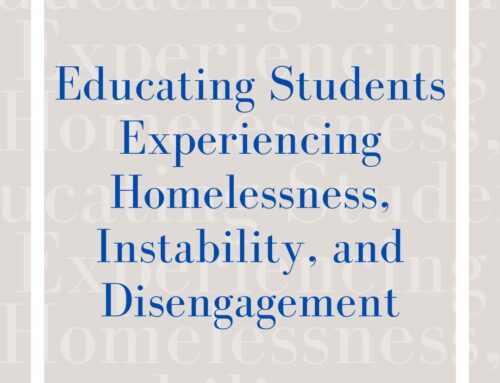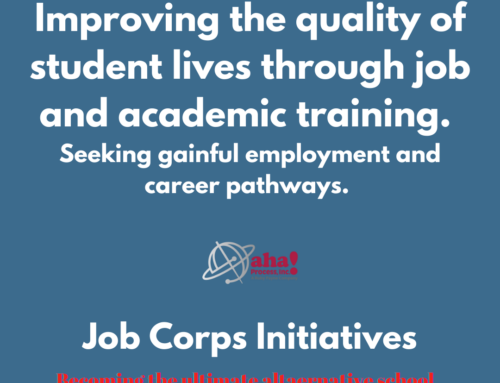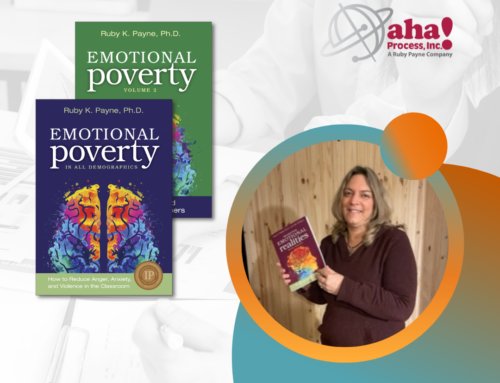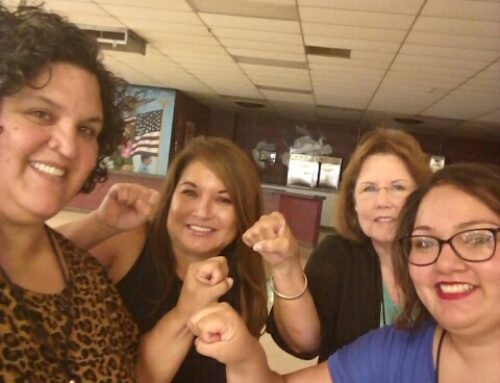by Ruby K. Payne, Ph.D.
Much discussion centers around the barriers that are created by poverty and the impact of poverty on education and on school success. Arguments span the spectrum from “it is a system problem” to “it is a school problem” to “it is an individual problem.” It would be myopic, in my view, to assign the blame solely to one cause. However, there are many things schools can do to make a difference in student achievement. I would identify the following dynamics:
1. RESOURCES OF THE HOUSEHOLD
Children from poverty are often defined almost exclusively by money. Actually, poverty is about nine resources: financial, emotional, mental, spiritual, support systems, relationships/role models, knowledge of hidden rules, physical, and language. Resource analysis is important because it suggests where to make interventions. For example, if the parent cannot read, there is no point in asking the parent to read to the child. Schools can be much more successful if they know the resources of students, then base interventions on the available resources.
2. VOCABULARY/SECOND LANGUAGE LEARNERS
Hart and Risley (1995) found in their research that the average 4-year-old in a professional household has heard 45 million words, while a 4-year-old in a welfare household has heard 13 million words. In fact, they found that a 3-year-old in a professional household has more vocabulary than an adult in a welfare household (Hart & Risley, 1995). Furthermore, Montano-Harmon (1991), a Latina linguist in California, found that the issue for many bilingual children is that they know only casual register in both languages and do not know formal register (language of school and work) in either language. Schools can be much more successful if they teach students to draw the meaning of vocabulary words and use discipline as an opportunity to teach formal register. (The student says something “sucks.” The student needs to find two other ways to say sucks as a newscaster would say it.)
3. EXECUTIVE FUNCTION PROCESSING
In a study released in 2009 using EEG scans with poor and middle class children, researchers found that the prefrontal cortex of the brain (executive function) in poor children was undeveloped and resembled the brains of adults who have had strokes (Kishiyama, Boyce, Jimenez, Perry, & Knight, 2009). The executive function of the brain handles impulse control, planning, and working memory. The researchers went on to state that it is remediable, but there must be direct intervention. Schools can direct teach planning and procedural steps and systematic processes (e.g., writing process, problem-solving process, etc.).
4. INTERGENERATIONAL TRANSFER OF KNOWLEDGE
 Part of human capital is a knowledge base. Knowledge bases are a form of privilege, just as social access and money are. Such knowledge bases also can be passed on intergenerationally. In an Australian study that followed more than 8,500 children for 14 years, the researchers found they could predict with reasonable accuracy the verbal reasoning scores of 14-year-olds based on the maternal grandfather’s occupation (Najman et al., 2004). Schools can teach knowledge bases to students because knowledge is a form of power.
Part of human capital is a knowledge base. Knowledge bases are a form of privilege, just as social access and money are. Such knowledge bases also can be passed on intergenerationally. In an Australian study that followed more than 8,500 children for 14 years, the researchers found they could predict with reasonable accuracy the verbal reasoning scores of 14-year-olds based on the maternal grandfather’s occupation (Najman et al., 2004). Schools can teach knowledge bases to students because knowledge is a form of power.
5. ABSTRACT REPRESENTATIONAL WORLD OF SCHOOL
Lave and Wenger (1991) indicate that beginning learning is about a situated environment that has people, relationships, context, tasks, and language. They add that when an individual makes the transition to formal schooling, learning becomes decontextualized. The context is taken away, relationships are seldom considered in the learning, and reasoning is not with stories but with laws and symbols (abstract representational systems). The research indicates that to make the transition between those two environments, one needs relationships and support systems. Schools can use mental models (stories, analogies, drawings) to translate between the sensory world and the abstract representational world.
While schools can’t relieve all the barriers of poverty for their students, they can provide relief in some areas while helping these children to succeed academically. Next week we’ll discuss another five strategies that make a difference in these children’s lives.
References
Hart, B., & Risley, T. R. (1995). Meaningful differences in the everyday experience of young American children. Baltimore, MD: Paul H. Brookes.
Kishiyama, M. M., Boyce, W. T., Jimenez, A. M., Perry, L. M., & Knight, R. T. (2009). Socioeconomic disparities affect prefrontal function in children. Journal of Cognitive Neuroscience, 21(6), 1106–1115.
Lave, J., & Wenger, E. (1991). Situated learning: Legitimate peripheral participation. New York, NY: Cambridge University Press.
Montaño-Harmon, M. R. (1991). Discourse features of written Mexican Spanish: Current research in contrastive rhetoric and its implications. Hispania, 74(2), 417–425.
Montaño-Harmon, M. R. (1994). Presentation given to Harris County Department of Education, Houston, TX.
Najman, J. M., Aird, R., Bor, W., O’Callaghan, M., Williams, G., & Shuttlewood, G. (2004). The generational transmission of socioeconomic inequalities in child cognitive development and emotional health. Social Science and Medicine, 58, 1147–1158.
Copyright 2013 by aha! Process, Inc. All rights reserved. www.ahaprocess.com
For the entire article and resources list, click here.








